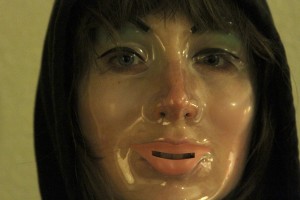V/H/S horrifies with sinister short films
In a time when the horror genre has hit an all-time low, V/H/S reminds audiences of what they’ve been missing.
As an anthology film, V/H/S features individual segments of varying quality, ranging from reasonably innovative and original to truly terrifying. At times, the content of these segments far surpasses the quality of any traditional horror film in the last 10 years, largely because it embraces truly dark thematic material.

Masked madame · Kate Lyn Sheil stars in “Second Honeymoon,” V/H/S’s second segment. The installment proves one of the best of the entire film and relies on a realistic rather than fantastical plot to scare viewers. – | Photo courtesy of Magnet Releasing
But when all is said and done, V/H/S is a true example of a film only as good as the sum of its parts. The assembly of the film is the largest flaw, and viewers are compelled to view V/H/S as a collection of short films rather than as a single, cohesive piece.
The body of the film contains five segments, and a sixth framing segment which establishes the anthology premise: a group of ragtag criminals invade an allegedly empty house in search of a crucial video tape. To find it, they must sift through a huge stack of VHS tapes, and these tapes contain the five core segments of the film.
Each segment has its own director, writer and crew, but they all share a common “found footage” style. The contrast from segment to segment creates one of the most intriguing elements of the film but also one of its chief weaknesses — the innovation evident in the first and second stories is largely absent from the third, reappears in the fourth and disappears again in the fifth. As such, audiences are left bored and jaded by the decreased quality in the third and fifth segments.
The framing segment, “Tape 56,” functions quite well as the film’s overarching story; it’s highly unnerving at times, but employs a slow-burn technique that allows us to feel somewhat more comfortable upon returning to the original narrative from one of the main stories. The main segment does have a satisfyingly creepy culmination — although that culmination comes too early — and “Tape 56” awkwardly ends before the fifth and final segment, making it an incomplete framing device.
“Amateur Night,” the first story in the body of the film, is quite possibly the best. It chronicles the simple story of three college-aged guys who go out to a bar and bring girls back to their hotel room. But this seemingly innocent premise is quickly transformed into something profoundly disturbing. “Amateur Night” features a nearly perfect pace, unfolding gradually but eventually unleashing horrifying moments that can make an audience full of grown men scream.
“Amateur Night” makes for an extraordinary first impression when watching the film but creates problems for subsequent segments, which fail to measure up to the quality of the first.
The second segment, “Second Honeymoon,” honestly tries to measure up to the horror-quality found in “Amateur Night” and is likely the next best of the film. This portion of V/H/S unfolds at a tortuously slow pace, much like the first segment, and involves a couple with a seemingly troubled relationship going on a road trip. There’s considerable innovation in the use of the found-footage premise in this segment, which organically generates much of the suspense. “Second Honeymoon” distinguishes itself by totally avoiding all references to the supernatural, instead relying on disturbingly real human behavior to unnerve the audience.
The first two segments are followed by a drastic drop in quality with “Tuesday the 17th,” which riffs on conventional ’80s slasher flicks: a group of teens ventures out into the woods for a risque weekend, only to discover the site of several grisly murders committed years earlier. This third segment has, by far, the weakest dialogue and performances and comes off as incredibly amateurish compared to the preceding sections of the film. It does have an interesting visual flair, but the section elicits more curiosity about how the visual effects are accomplished than actual fear.
Thankfully, the film picks back up with the fourth segment, “The Sick Thing that Happened to Emily When She Was Younger.” This segment uses a webcam conceit to delineate the story of an off-kilter long-distance relationship between two young people. Their video chat interactions comprise the whole running time of the segment. Though the use of the webcam ends up being more of a gimmick than a valid storytelling device, the segment nonetheless has terrific scares and a sharp, unpredictable storyline.
The film concludes with the fifth segment, “10/31/98,” an enjoyable piece that, unfortunately, loses most of its suspense after the first few minutes. It involves a group of friends arriving at a Halloween party to find the house eerily empty, though audiences quickly realize it might not be so empty after all. “10/31/98” generates strong jump scares and moments of surprising levity as well as a strong ending that would work well as a transition into another segment, but unfortunately, the film ends there, without returning to the framing device or providing a truly satisfying climax.
As such, the film’s strongest elements are individual segments, and the whole lacks cohesion and punch. Nonetheless, three of the individual segments are so strong that those weaknesses seem irrelevant in comparison to a momentary reinvigoration of the horror genre.

Just saw this a little over a week ago and I agree: the entirety of the movie is so-so, but three or so of the fragmented VHS segments were very well done and saves the movie.